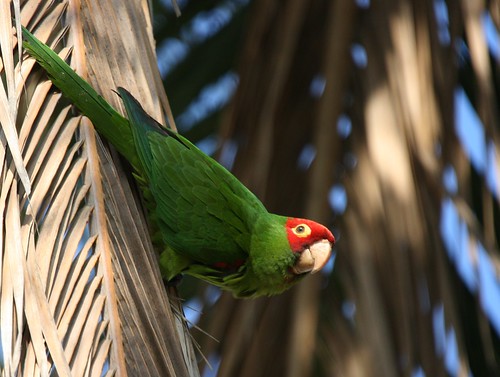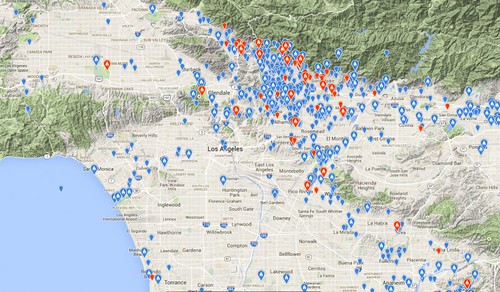 Red-masked parakeet in Ocean Beach, SD, CAIf you want to be the life of the party, chat it up about parrots in Southern California—but keep three things in mind: green doesn't mean much, “eBird” refers not to an avian email service but a parrot population tracker and a squawk is worth a thousand words.
Red-masked parakeet in Ocean Beach, SD, CAIf you want to be the life of the party, chat it up about parrots in Southern California—but keep three things in mind: green doesn't mean much, “eBird” refers not to an avian email service but a parrot population tracker and a squawk is worth a thousand words.
There are around 13 documented parrot species in California, all of which are green, and all of which are loud. Parrots are social birds, travelling in flocks and screeching in a chorus about important bird business.
Even though these birds hail from savannahs and open woodlands of Mexico and South America, they thrive in the residential and urban environment in Los Angeles.
So if you're a SoCal native you'll have noticed them—if you haven't, then you likely live in the mountains or the ocean, because that's the only place they won't be found.
Despite their numbers, however, parrot populations prove hard to track. Ornithologist Kimball Garrett manages the avian collections at the Natural History Museum and established the website The California Parrot Project, which tracks Californian parrot species populations.
"They're still expanding geographically," said Garrett. "So if you're noticing more around you it could be they've just discovered your area."
That's not to say that the species aren't expanding in numbers, just that there's no concrete way to track them. A local population increase could be any combination of changes in population or spread.
How did they get here in the first place?
"Most people have heard the same rumor," said Bella Chu, Temple City resident. "There was a fire at a pet store, and from that fire all of those beautiful green parrots escaped and started procreating."
While this may be true, a few birds from a pet store could not establish a population of thousands.
"There was a massive legal importation up into the 1980s, and especially in the '60s and '70s," Garrett said. "There's not really documentation for when they were brought. A lot of the importation has been illegal, too."
Modern parrot populations were established, in all likeliness, from descendants of escapees from the illegal or legal trade.
With Cornell's eBird, a user can find, among other fun information for birders, crowdsourced population information for any bird species all over the world.
There, you can sift through the decades of data yourself—or, you can register and report your sightings. They'll show up on the map like Google Maps icons, and you can see the history of sightings at that and any location, for any species.
So if you want to get down to business and look for one of these little fluffers, the trick is to listen.
"When they're calling, you can't miss them," said Garrett. "But often when they get in the trees, they just disappear."
The future of the Southern California parrot population is uncertain.
"With these parrots, I hesitate to make any predictions," Garrett said, "50 years from now, they could be all over California, 50 years from now, they could virtually all be gone."
No matter how loud or annoying they get, don't forget to look up to the skies every once in a while; after all, you never know what you've squawk until it's gone.
